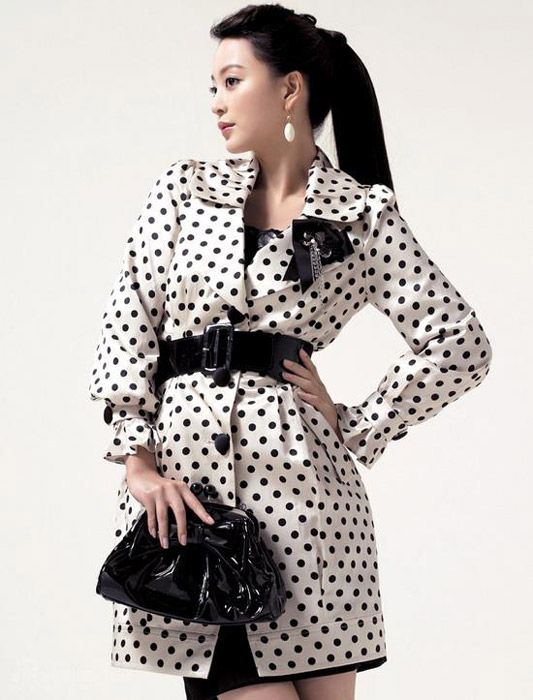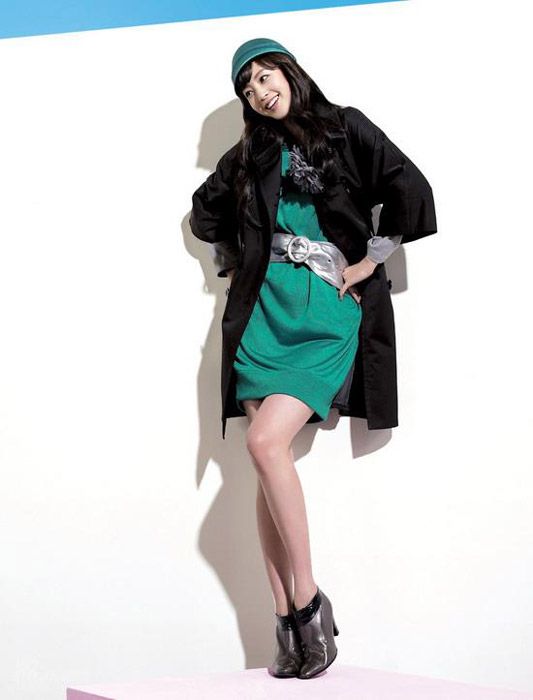Saturday, October 9, 2010
Wednesday, October 6, 2010
Jidai Matsuri 2006: Heian Style
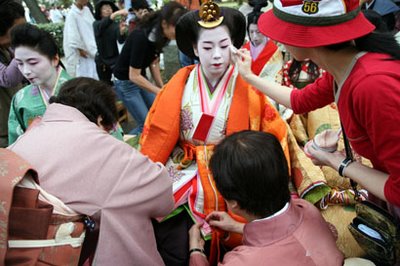
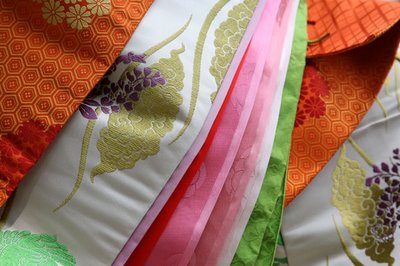
 Colors and patterns of the "juni-hitoe" (12 layers- a rather arbitrary number, as some women wore as many as 20) reflected many things, including: rank, seasons, directions, virtues, and elements of the earth as they related to spirits of nature. The multiple layers also helped in staying warm in winter. Eventually, sumptuary laws of the Edo Period standardized the number of layers to five.
Colors and patterns of the "juni-hitoe" (12 layers- a rather arbitrary number, as some women wore as many as 20) reflected many things, including: rank, seasons, directions, virtues, and elements of the earth as they related to spirits of nature. The multiple layers also helped in staying warm in winter. Eventually, sumptuary laws of the Edo Period standardized the number of layers to five.
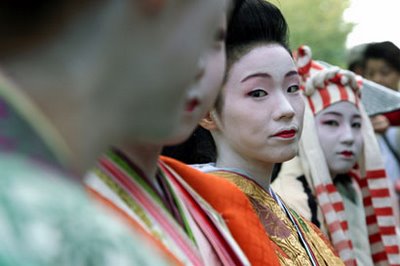



Wednesday, October 25, 2006
Kyoto Nights
Mamehide rushing through Shirakawa (Gion) on her way to an engagement. Both her Kimono ensemble and her kanzashi, particular to October, celebrate the beauty of fall in Japan. Her kimono and collar are decorated with momiji, Japanese maple leaves, and kiku, chrysanthemums, the symbol of the Imperial family and a much beloved flower in Japan. The small green ornament is the famous tsunagi dango, the linked dumpling crest of Gion, which symbolizes the solidarity between the different geiko districts. Her upper lip is not painted, alluding to her rank as a first year maiko. Her collar is heavily embroidered in red, which also points to her low rank. As maiko advance in the ranks, their collars become predominantly whiter until they are ready to become a full fledged Geiko.
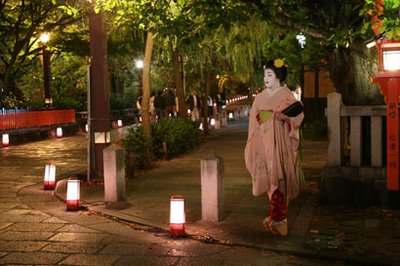
A quite night in Gion. Katsue, a young, high ranking maiko from Kamishichiken, standing near the small shrine enjoying lantern lit Shirakawa.
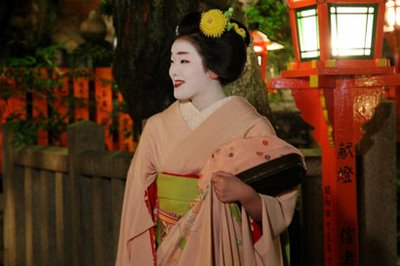 Katsue greeting a friend with a smile. Note her white collar, crimson lips, and kanzashi (hair ornament). As a higher ranking maiko, she no longer wears the long, dangling bira bira kanzashi that Mameteru is wearing above. Instead she wears a simple chrysanthemum blossom.
Katsue greeting a friend with a smile. Note her white collar, crimson lips, and kanzashi (hair ornament). As a higher ranking maiko, she no longer wears the long, dangling bira bira kanzashi that Mameteru is wearing above. Instead she wears a simple chrysanthemum blossom.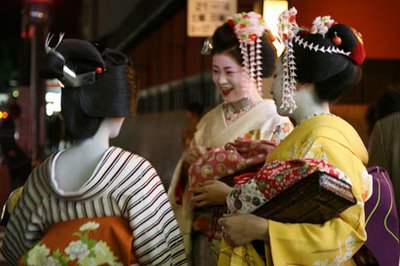 Two young maiko laugh with their big sister on the corner of the Hanamikouji and Shijo, Gion.
Two young maiko laugh with their big sister on the corner of the Hanamikouji and Shijo, Gion.
Friday, October 20, 2006
Kyoto: Where My Heart Belongs
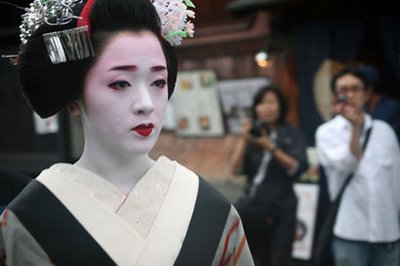 Almost Famous: Kotoha, A young, high rank maiko named Kotoha makes her to the big party at the Ichiriki teahouse after the main procession of Yamahoko Junko last July.
Almost Famous: Kotoha, A young, high rank maiko named Kotoha makes her to the big party at the Ichiriki teahouse after the main procession of Yamahoko Junko last July. I'm headed to Kyoto for Jidai Matsuri: The Festival of Ages. I haven't been to Kyoto since July(way too long) but here are some of the photos I took during the summer and never got around to sharing. Enjoy!
 A young, first year maiko on her way to an appointment during Gion Matsuri. Geiko still use traditional, oiled paper umbrella in the rain and snow. This was my first time actually seeing a maiko or geiko use one. Breath-taking. This is also the first image taken with my new camera (^-^)/ I'm still learning how to use it. Non-stop pouring rain + fast moving maiko = a great learning experience! The blur helps conveys the hustle and bustle of the crowded street, the young maiko rushing through the crowd to her appointment, and the dreary, dripping rain. It looks ethereal, like a scene from a dream, which is exactly the way I felt when I shot it.
A young, first year maiko on her way to an appointment during Gion Matsuri. Geiko still use traditional, oiled paper umbrella in the rain and snow. This was my first time actually seeing a maiko or geiko use one. Breath-taking. This is also the first image taken with my new camera (^-^)/ I'm still learning how to use it. Non-stop pouring rain + fast moving maiko = a great learning experience! The blur helps conveys the hustle and bustle of the crowded street, the young maiko rushing through the crowd to her appointment, and the dreary, dripping rain. It looks ethereal, like a scene from a dream, which is exactly the way I felt when I shot it.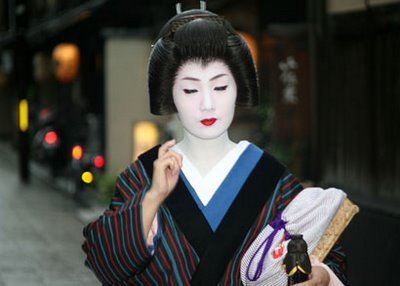 Eyes Wide Closed: Gion. A geiko making her daily communte through the streets of Gion. Geiko wear wigs called katsura, with almost no ornamentation (compared to maiko, who style their own hair, which is adorned with many kanzashi, or flowered ornaments). Of course she blinked the exact moment I pressed the shutter, but what a perfect face.
Eyes Wide Closed: Gion. A geiko making her daily communte through the streets of Gion. Geiko wear wigs called katsura, with almost no ornamentation (compared to maiko, who style their own hair, which is adorned with many kanzashi, or flowered ornaments). Of course she blinked the exact moment I pressed the shutter, but what a perfect face. A young geiko waiting outside the Ichiriki Teahouse in Gion with her client. Customers pay about $200 dollars an hour for the privledge of spending time with geiko (kyoto dialect for geisha), but having money is not the only requirement. Customers must have a relationship with an ochaya, a place where geiko entertain, in order to make an appointment, and being introduced to an ochaya is no simple task. The refined manners of Kyoto dictate that charging a customer at the end of the night is a no-no. With bills often running past 5,000$ a night, Ochaya must have a relationship based on trust, so that they can rest assured that the bills that they send to their customers once a month will be paid.
A young geiko waiting outside the Ichiriki Teahouse in Gion with her client. Customers pay about $200 dollars an hour for the privledge of spending time with geiko (kyoto dialect for geisha), but having money is not the only requirement. Customers must have a relationship with an ochaya, a place where geiko entertain, in order to make an appointment, and being introduced to an ochaya is no simple task. The refined manners of Kyoto dictate that charging a customer at the end of the night is a no-no. With bills often running past 5,000$ a night, Ochaya must have a relationship based on trust, so that they can rest assured that the bills that they send to their customers once a month will be paid.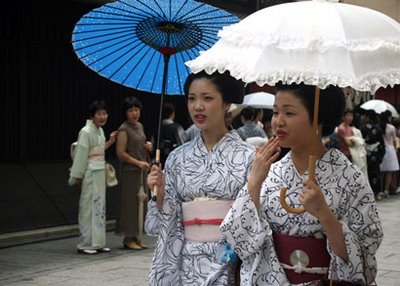 Two maiko make their way through the busy streets of Gion, sheltered from the sweltering summer sun by their umbrellas. Daytime casual: No white makeup, no heavy silk kimono. Just cotton yukata and lip gloss (^-^). I've never seen a maiko with a western umbrella before (right). Interesting. Also love the way the two older women watched them pass with awe, reverence and pride.
Two maiko make their way through the busy streets of Gion, sheltered from the sweltering summer sun by their umbrellas. Daytime casual: No white makeup, no heavy silk kimono. Just cotton yukata and lip gloss (^-^). I've never seen a maiko with a western umbrella before (right). Interesting. Also love the way the two older women watched them pass with awe, reverence and pride.It is a Japanese custom for women to cover their mouths when smiling,laughing, and even sometimes, speaking. This young maiko was laughing as she talked with her friend, which is as she talked with her friend, which is why her hand is raised just so.
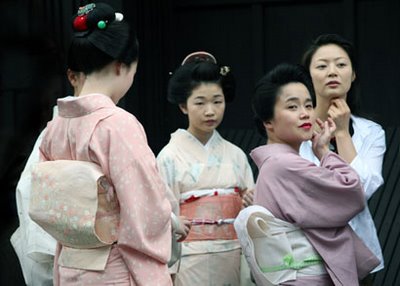 An older "sister", an accomplished and high ranking geiko, accompanying a few younger maiko, or apprentice geisha, to a tea ceremony held at the famous Ichiriki Teahouse. The way the older women on the right hold themselves, and the sensual way they touch themselves, even in such a casual way....
An older "sister", an accomplished and high ranking geiko, accompanying a few younger maiko, or apprentice geisha, to a tea ceremony held at the famous Ichiriki Teahouse. The way the older women on the right hold themselves, and the sensual way they touch themselves, even in such a casual way....Women of the Ages: Jidai Matsuri
 Jidai Matsuri, Kyoto`s Festival of Ages, started as a way to revitalize Kyoto after Japan's capitol moved to Tokyo. It has now grown to include over two thousand participants (Kyoto residents, including Maiko and Geiko) dressed in authentic period costumes from throughout Japan`s history valued at over $25 million.
Jidai Matsuri, Kyoto`s Festival of Ages, started as a way to revitalize Kyoto after Japan's capitol moved to Tokyo. It has now grown to include over two thousand participants (Kyoto residents, including Maiko and Geiko) dressed in authentic period costumes from throughout Japan`s history valued at over $25 million.Izumo-no-Okuni (1600), the mother of Kabuki, was once a maiden in the service of the Izumo Shrine, one of Japan’s holiest Shinto shrines. She later became famous for her dancing, and legend holds that her troup`s first performance took place in the dry bed of the Kamo River. These dances were very popular (I have been told the originall characters used to write kabuki meant song, dance and prostitution), so popular that the Tokugawa shogunate banned women from the stage. From then on, all roles have been placed by men. Today Kabuki is written with characters meaning song, dance and skill.
Lady Shizuka (played by Masayo, a high ranking maiko from Gion Higashi), a famed Kyoto dancer of the late 12th century,was the lover of the hero Minamoto-no-Yoshitsune, a brilliant Genji general in the Gempei War (1180-1185). His success, however, earned him the distrust of his half-brother, Yoritomo, the leader of the Genji (vs. the Heike). In 1185, Yoritomo forced his half-brother to flee and live like an outlaw.
Four years later, facing capture and certain execution, Yoshitsune committed suicide. Shizuka, pregnant with his child, was captured by Yoritomo. Reportedly, she danced for him and so charmed him that Yoritomo spared her life and that of her unborn child only if it was a girl. Unfortunately, a son was born and soon killed to prevent him from seeking vengeance for his father's death later in life.
Spotlight YouTube Beauty Guru: manwomanfilm
The one and only manwomanfilm of YouTube creates stunning makeup looks with her mellow soundtracks and impressive video editing techniques. Seriously, the girl has skills!
Her videos are not your typical makeup tutorials. There is never dialogue or voice overs. She transforms her adorable self into such characters as a angelic dancer, flight attendant, and blooming pink rose. You can take her techniques and morph them into an everyday or a special occasion look. When we first saw her videos on YouTube, we couldn’t stop watching all of them from beginning to end. She seems to bring such an geniune passion for makeup and has no fear on color risks and outfits. We adore her creativity and sparkling smile. Manwomanfilm, you give us the inspiration to break out of our safe zone!
Monday, October 4, 2010
The 9th China International Fashion Week
A model presents a creation at the 9th China International Fashion Week, which opened in Beijing on Nov 16. Activities such as fashion show, design contest, forum etc will give people a better understanding of fashions in China.






 I love you, too, Beautiful Mountain School!
I love you, too, Beautiful Mountain School! 